
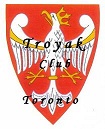
TROYAK EXECUTIVE TEAM is informing all members, colleagues, collectors, and Polonia at large, that Club meetings taking place at John Paul II Polish Cultural Centre, 4300 Cawthra Rd. (just south of Hwy. 403), Mississauga, Ontario. The new members are always welcome. www.polishculturalcentre.ca
ADRES SPOTKAÑ KLUBOWYCH ! Zarząd Główny Klubu “Troyak” informuje wszystkich członków kolekcjonerów, sympatyków oraz całą Polonię, że spotkania klubowe odbywają się w Polskim Centrum Kultury im. Jana Pawła II, przy 4300 Cawthra Rd. (na południe od autostrady 403), Mississauga, Ontario. Zapraszamy nowych członków do prężnego. Klubu “Troyak”. www.polishculturalcentre.ca


“TROYAK” CLUB NEXT MEETINGS …
NASTĘPNE SPOTKANIA KLUBU “TROYAK” …
Sunday 26th May 2024 @ 4:30 p.m.
30th June 2024
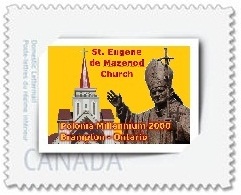
July & August 2024 – Summer break … Letnie wakacje …

TROYAK CLUB @ Roncesvalles Polish Festival 2024
Saturday, September 14th, 2024 … Festival Hours: 11:00am to 11:00pm
Sunday, September 15th, 2024 … Festival Hours: 11:00am to 7:00pm
https://polishfestival.ca www.kazimierz.org
St. Casimir’s Church
Parish Hall … 156 Roncesvalles Ave. Toronto, Ontario
Stamp Exhibit … Pope John Paul II on World Stamps and
Displays of Coins, Stamps, Collectibles by Troyak Club Members.
Roncesvalles Polish Festival
www.troyakclub.com

29th September 2024; 27th October 2024
24th November 2024

Sunday – 1st December 2024 @ 9:00 a.m. to 4:00 p.m.
Mississauga Coin & Stamp Show
December 2024 … Happy Holidays!


25 lat Polski w NATO
www.poczta-polska.pl
W dniu 12 marca 2024 roku został wprowadzony do obiegu znaczek pocztowy o wartości: PRIORYTETOWY M, 5,40 zł, emisji “25 Lat Polski w NATO”. Najnowszy walor filatelistyczny przypomina o jednym z najważniejszych sukcesów polskiej polityki ostatnich dziesięcioleci, który stanowił krok milowy dla zapewnienia trwałego bezpieczeństwa Polek i Polaków. Na jubileuszowym znaczku przedstawiono orła białego oraz logotyp NATO – różę kompasową, symbol dążenia do zapewnienia bezpieczeństwa ze wszystkich stron. Kompozycja została umieszczona na błękitnym tle, symbolizującym zgodę i nawiązującym do Oceanu Atlantyckiego. Emblematy umieszczono naprzemiennie obok rocznicowej cyfry. Całość kompozycji została uzupełniona biało-czerwoną wstęgą. Znaczki wydrukowano techniką rotograwiurową, na papierze fluorescencyjnym, w formacie 25,5 x 31,25 mm, w nakładzie 1 000 000, powtarzalnym. Arkusz sprzedażny zawiera 100 sztuk znaczków. Autor projektu: Jarosław Ochendzan. Nową emisję waloru uzupełnia koperta Pierwszego Dnia Obiegu (FDC), której centralny motyw stanowią powiewające na wietrze flagi Polski i NATO. Wydawnictwu towarzyszy również okolicznościowy datownik, który w swojej grafice prezentuje widok na kolumnę Zygmunta i Zamek Królewski w Warszawie oraz informacje o dacie i miejscu wprowadzenia znaczka do obiegu.
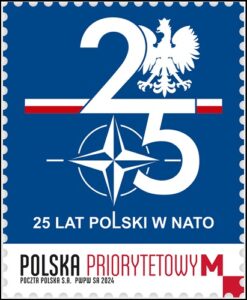
–Ćwierćwiecze obecności Polski w NATO bezsprzecznie zasługuje na uhonorowanie na znaczku pocztowym, wpisując się w misję Poczty – promowania ważnych dla Polaków wydarzeń, rocznic czy inicjatyw. Walory filatelistyczne podróżują wraz z listami i kartkami, docierając do każdego zakątka kraju – i nie tylko. Najnowsza emisja filatelistyczna nie tylko przypomina o jednym z najważniejszych sukcesów polskiej polityki ostatnich dziesięcioleci, ale również stanowi wyraz podziękowania dla wszystkich osób zaangażowanych w proces budowania naszego bezpieczeństwa – powiedział Sebastian Mikosz, p.o. Prezes Poczty Polskiej.
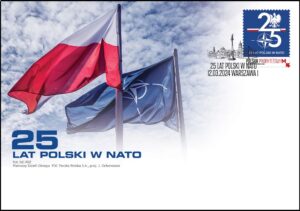
Polska droga do NATO … Organizacja Traktatu Północnoatlantyckiego powstała w 1949 r. na mocy podpisanego w Waszyngtonie przez 12 państw Traktatu Północnoatlantyckiego. Celem utworzenia Sojuszu Północnoatlantyckiego była obrona przed ewentualną agresją ze strony ZSRS, a później państw Układu Warszawskiego. Po zakończeniu Zimnej Wojny i rozpadzie ZSRS w 1991 r., NATO angażowało się w misje i operacje wojskowe m.in. w Afganistanie, Kosowie i Libii. Wieloletnie starania dyplomatyczne oraz reformy przeprowadzone m.in. w sferze obronności zaowocowały 12 marca 1999 r. przyjęciem Polski do Sojuszu Północnoatlantyckiego. Minister Spraw Zagranicznych RP, prof. Bronisław Geremek przekazał na ręce Sekretarz Stanu USA, Madeleine Albright akt przystąpienia Polski do Traktatu Północnoatlantyckiego. Z tą chwilą Rzeczpospolita Polska stała się formalnie stroną Traktatu – członkiem Sojuszu Północnoatlantyckiego. Przez ostatnie 25 lat pozycja Polski w NATO stale rosła.

2024 … Cyfrowa filatelistyka …
Poczta Polska kolekcja Kryptoznaczków
www.poczta-polska.pl
W nieco ponad rok od prezentacji pierwszej kolekcji Kryptoznaczka „Polska w kosmosie”, Poczta Polska wprowadziła do sprzedaży drugą emisję „W przestworzach”. Nowa emisja została wprowadzona do sprzedaży 27 marca 2024r. Cyfrowe kolekcjonerstwo online, wykorzystujące technologię blockchain, jest już faktem. Emisja „W przestworzach” stanowi najnowszą główną kolekcję Polskiego Kryptoznaczka, oznaczoną numerem 2.0. Prezentuje ona surrealistyczne obrazy balonów autorstwa cenionego artysty Andrzeja Gosika, który jest zarówno malarzem, ilustratorem, jak i autorem akwareli. Kompozycje są pełne baśniowych odwołań, mają charakter zagadkowy, a dominuje w nich niezwykły język form. Istotnym elementem tego stylu jest właśnie niejednoznaczność, która pobudza do głębszej refleksji i własnych interpretacji. Całość zbioru dzieł sztuki Gosika zaprezentowano w 2022 roku na wystawie zorganizowanej w Zamku-Muzeum w Łańcucie, co stanowiło wyraz uznania dla Jana Potockiego – pierwszego Polaka, który odbył podróż balonem w 1790 roku. Inspirując się tymi dziełami sztuki, Roch Stefaniak stworzył cztery Kategorie Polskiego Kryptoznaczka 2.0, które zarazem stanowią doskonałą promocję polskiego malarstwa współczesnego. Te niezwykłe obrazy balonów zostały wykorzystane zarówno w projektach tradycyjnych znaczków pocztowych (wydanych 18 października 2023 roku), jak i w formie Kryptoznaczków.

Motyw balonów został wykorzystany i pojawił się również w piątej kategorii Polskiego Kryptoznaczka (jedynie wersja cyfrowa), stworzonego przy użyciu sztucznej inteligencji i dostępnego w czterech różnorodnych wariantach graficznych. AI obecnie odgrywa ważną rolę w postępie wielu dziedzin życia, wpływając na optymalizację różnorodnych procesów. W obszarze sztuki, jak to ma miejsce w przypadku Polskiego Kryptoznaczka, sztuczna inteligencja może stanowić wsparcie dla artystów w kreowaniu wyjątkowych dzieł, co przyczynia się do wzbogacenia kultury oraz otwiera nowe możliwości wyrazu artystycznego. Wydając Kryptoznaczek, Poczta Polska łączy tradycyjną działalność Poczty z nowoczesnymi technologiami, przenosząc filatelistykę do wymiaru cyfrowego. Dzięki Kryptoznaczkowi tradycyjne zbieranie i wymiana znaczków stają się dostępne również online poprzez blockchain, przekształcając tokeny NFT w cyfrowe kolekcjonerskie eksponaty. Po zakupie klient otrzymuje zarówno wersję tradycyjną znaczka, jak również specjalne kody do pobrania jego wersji cyfrowej do swojego portfela. Dzięki temu kolekcjoner ma możliwość przechowywania tradycyjnej wersji Kryptoznaczka w klaserze, natomiast wersję cyfrową może umieścić w Kryptoklaserze.
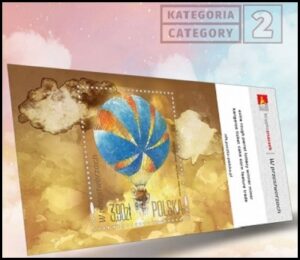
Tradycyjne foldery filatelistyczne z dodatkiem specjalnym NFT oraz koperty FDC towarzyszące emisji … Elementem kolekcji Polski Kryptoznaczek 2.0 jest folder z tradycyjnym nieperforowanym znaczkiem tej emisji w nakładzie 2 tys. egz. Co więcej, każdy egzemplarz folderu zawiera token NFT z odniesieniem do dedykowanej animacji oraz cztery karty wydane na polichlorku winylu nawiązujące graficznie do znaczków tej emisji. Emisji towarzyszy również Kryptokoperta NFT opatrzona Kryptostemplem dostępna w 4 kategoriach cenowych w zależności od wybranego Kryptoznaczka. W Kolekcji Polskiego Kryptoznaczka znajdują się także cyfrowe Talary Filatelistyczne, stanowiące specjalny rodzaj tokenów.

Dotychczasowe Kryptowalory Poczty Polskiej … Oprócz wydań kolekcji głównych Poczta Polska wyemitowała w 2023 roku limitowane kolekcje specjalne, np. Kryptoznaczek „Odsiecz wiedeńska” oraz „Bitwa pod Chocimiem”, którym towarzyszą unikatowe Kryptokoperty FDC i Kryptofoldery. We współpracy z Polskim Radiem wprowadzono również na rynek unikalne Kryptopocztówki. Muzyczne kartki NFT. To pierwsze tego typu wydawnictwo na świecie dostępne w limitowanej liczbie 4 tysięcy egzemplarzy.
Komunikacja projektu Polskiego Kryptoznaczka prowadzona jest na:
https://discord.com/invite/YWpAGBwhqa/ https://twitter.com/filatelistyka/ oraz
https://www.facebook.com/FilatelistykaMojeHobby/
oraz www.poczta-polska.pl

90 lat Towarzystwa im. Fryderyka Chopina w Warszawie
www.poczta-polska.pl
W dniu 11 kwietnia 2024 r. została wprowadzona do obiegu kartka pocztowa z nadrukowanym znakiem opłaty pocztowej, emisji: 90 lat Towarzystwa im. Fryderyka Chopina w Warszawie. Wartość nominalna znaku opłaty pocztowej z oznaczeniem literowym A odpowiada wartości nominalnej znaczka pocztowego używanego do uiszczenia opłaty za ekonomiczną przesyłkę listową nierejestrowaną, w tym kartkę pocztową, w obrocie krajowym, w formacie S.
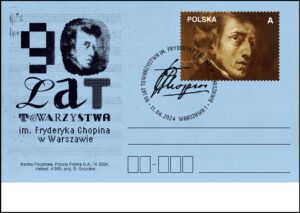
W prawym górnym rogu strony adresowej kartki nadrukowano znak opłaty pocztowej, na którym umieszczono zdjęcie Fryderyka Chopina, w lewym górnym rogu znajduje się napis: POLSKA, a w prawym górnym oznaczenie wartości: A. W części ilustracyjnej kartki umieszczono w tle pięciolinie z nutami, logo Towarzystwa im. Fryderyka Chopina oraz stylizowany napis ,,90 lat Towarzystwa im. Fryderyka Chopina w Warszawie”. Kartkę o wymiarach 148 x 105 mm wydrukowano jednostronnie, techniką offsetową, na kartonie białym, w nakładzie 4 000 sztuk. Autor projektu kartki: Bożydar Grozdew.

Europa – Podwodna fauna i flora
www.poczta-polska.pl
W dniu 25 kwietnia 2024 r. Poczta Polska wprowadziła do obiegu nowy znaczek pocztowy o wartości 4,90 zł emisji EUROPA, którego głównym tematem jest podwodna fauna i flora. Na znaczku została zaprezentowana ryba brzana, symbolizująca bogactwo ekosystemów wodnych, których ochrona stanowi kluczowy element w utrzymaniu równowagi środowiskowej. Znaczek wydrukowano techniką offsetową , na papierze fluorescencyjnym, w formacie znaczka 43 x 31,25 mm, w nakładzie 144.000 sztuk. Arkusz zawiera 12 znaczków (tête-bêche).
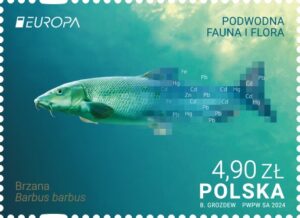
Tegoroczna emisja znaczków z serii EUROPA ma na celu promowanie ochrony środowiska naturalnego oraz zachęcanie do podejmowania szerokich inicjatyw w tym zakresie. Przede wszystkim stawia sobie za zadanie odwrócenie trendu degradacji najbardziej charakterystycznych dla całej Europy środowisk wodnych wielkich rzek nizinnych, które od wieków odgrywały istotną rolę w krajobrazie, gospodarce i życiu społeczności. W projekcie autorstwa Bożydara Grozdewa wykorzystano zdjęcie wykonane przez Irenę Stangierską, uznaną fotografkę podwodną. Brzanę, reprezentanta gatunku ryb słodkowodnych (Barbus barbus) z rodziny karpiowatych, umieszczono w otoczeniu symboli pierwiastków chemicznych, takich jak ołów, rtęć i żelazo, które stanowią część zanieczyszczeń środowiska. Symbole te składają się w ogon ryby, tworząc wymowną kompozycję. Szersze fotograficzne ujęcie wodnego środowiska z jego florą i fauną zostało wykorzystane do projektu koperty pierwszego dnia obiegu FDC. Emisji towarzyszy również okolicznościowy datownik z graficznym wyobrażeniem strzałki wodnej, gatunku byliny charakterystycznego dla płytkich akwenów.

Wybór brzany na znaczek pocztowy nie był przypadkowy. Ten gatunek, jako bioindykator, odgrywa istotną rolę w ocenie jakości wody. Bioindykatory są organizmami, których obecność, zachowanie lub właściwości fizjologiczne są wykorzystywane do oceny stanu środowiska. Dzięki swojej wrażliwości na spadek zawartości tlenu w wodzie, brzana jest swoistym wskaźnikiem jakości wody. Jej występowanie w ekosystemie pozwala stwierdzić, że środowisko wodne jest stosunkowo zdrowe i wolne od zanieczyszczeń.
Seria znaczków EUROPA stanowi wspólny projekt europejskich administracji pocztowych. Znaczki te wydawane są nieprzerwanie od 1956 roku i zawsze zawierają oficjalne logo EUROPA, będące znakiem towarowym stowarzyszenia publicznych administracji pocztowych PostEurop. Tematy przewodnie wydawnictw zwykle związane są z kulturą, historią, przyrodą lub osiągnięciami danego kraju, lub regionu, a znaczki serii symbolizują współpracę między operatorami pocztowymi oraz propagują wspólne wartości. Ich różnorodność tematyczna oraz fakt, że często są wydawane w limitowanych nakładach lub w specjalnych edycjach, przyczyniają się do ich popularności wśród kolekcjonerów znaczków pocztowych.

Rośliny chronione
www.poczta-polska.pl
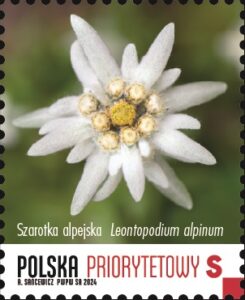
W dniu 25 kwietnia 2024 r. został wprowadzony do obiegu znaczek pocztowy o wartości właściwej do uiszczania opłaty za przesyłkę listową nierejestrowaną priorytetową w obrocie krajowym w formacie S i priorytetową kartkę pocztową w obrocie krajowym (5,80 zł) emisji “Rośliny chronione”. Na znaczku przedstawiono kwiat szarotki alpejskiej, której jedyne naturalne stanowisko w Polsce znajdują się w Tatrach.
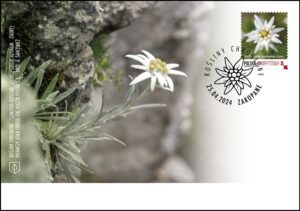
Wzdłuż dolnej krawędzi znaczka umieszczono napisy: POLSKA i PRIORYTETOWY S. Znaczek wydrukowano techniką rotograwiurową, na papierze fluorescencyjnym, w formacie 25,5 x 31,25 mm, w nakładzie 5 000 000 szt., powtarzalnym. Arkusz sprzedażny zawiera 100 znaczków. Z tej okazji została wydana również koperta FDC. Autor projektu znaczka: Agnieszka Sancewicz.


Pamięci Rodziny Ulmów
www.nbp.pl
Narodowy Bank Polski jest centralnym bankiem państwa odpowiadającym za politykę pieniężną i stabilność cen. Jego funkcje określa Konstytucja Rzeczypospolitej Polskiej i ustawa o NBP. NBP ma wyłączne prawo emisji pieniądza. Jako bank centralny nie prowadzi rachunków bankowych obywateli, nie przyjmuje od nich lokat, nie udziela kredytów. Prowadzi natomiast obsługę budżetu państwa, a także podmiotów sektora finansów publicznych. Gromadzi rezerwy walutowe państwa i zarządza nimi. Pełni funkcję banku banków, tworząc warunki do działania systemu bankowego. Jest również jednym z najważniejszych ośrodków naukowo-analitycznych w dziedzinie ekonomii i rynków finansowych.
Emisja wartości kolekcjonerskich stanowi okazję do upamiętniania ważnych historycznych rocznic i postaci oraz do rozwijania zainteresowań polską kulturą, nauką i tradycją. 22 lutego 2024 roku Narodowy Bank Polski wprowadził do obiegu srebrną monetę o nominale 50 zł „Pamięci Rodziny Ulmów”.
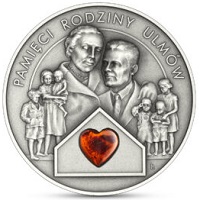

Nominał: 50 zł … metal: Ag 999/1000; stempel: zwykły, oksyda, bursztyn; średnica: 45,00 mm; masa: 62,20 g; brzeg (bok): gładki; nakład: do 5 000 szt.; Projektantk: Robert Kotowicz; Emitent: NBP; Na zlecenie NBP monety wyprodukowała Mennica Polska SA.
Rewers monety przedstawia Błogosławioną Rodzinę Ulmów – Józefa i Wiktorię oraz dzieci: Stanisławę, Barbarę, Władysława, Franciszka, Antoniego i Marię. Bursztyn w kształcie serca symbolizuje siódme dziecko. Na awersie monety została umieszczona kompozycja z liścia palmy i kwiatów lilii – liść palmy to symbol męczeństwa, natomiast siedem kwiatów lilii symbolizuje niewinność siedmiorga dzieci.
Markowa to wieś położona kilka kilometrów od Łańcuta. W przededniu wybuchu II wojny światowej liczyła około 4,5 tys. mieszkańców, w tym 120 Żydów. W pierwszej połowie 1942 r. na tych terenach Niemcy wprowadzili restrykcje wynikające z zarządzenia Generalnego Gubernatora Hansa Franka z 15 października 1941 r., które dotyczyły m.in. niemal całkowitego odcięcia dostępu do żydowskich dzielnic mieszkaniowych i zakazu opuszczania gett przez Żydów, a także wprowadzenia kary śmierci za pomoc udzielaną im przez mieszkańców Generalnego Gubernatorstwa. Wiktoria i Józef Ulmowie byli małżeństwem od 1935 r. i mieli sześcioro dzieci: Stanisławę, Barbarę, Władysława, Franciszka, Antoniego oraz Marię. Pracując w gospodarstwie rolnym, zajmowali się sadownictwem i uprawą warzyw oraz hodowlą jedwabników i pszczelarstwem. Przed wybuchem wojny Józef działał społecznie w ramach Katolickiego Stowarzyszenia Młodzieży, a także w Związku Młodzieży Wiejskiej RP „Wici”. Był znany z licznych pasji, takich jak fotografia, elektrotechnika i historia. Wiktoria przed zamążpójściem była słuchaczką kursów zawodowych na Uniwersytecie Ludowym w Gaci, a później zajmowała się już wyłącznie dziećmi i prowadziła dom. Jesienią 1942 r. rodzinę Ulmów poprosili o schronienie Saul Goldman z synami: Baruchem, Mechelem, Joachimem oraz Mojżeszem, a na początku kolejnego roku – krewne Saula, Gołda Grünfeld i Lea Didner z córką Reszlą.
Pomoc, której Ulmowie udzielili swoim żydowskim znajomym, miała szanse powodzenia, ponieważ ich dom znajdował się na obrzeżach wsi. Przerażającym ostrzeżeniem dla mieszkańców Markowej była masowa egzekucja ponad 20 jej żydowskich mieszkańców, której dokonano 14 grudnia 1942 r. Miejsce kaźni było widoczne z podwórka domostwa Ulmów, dlatego można przypuszczać, że wszyscy jego mieszkańcy widzieli niemiecką zbrodnię. Ponad rok później doszło do tragedii w domu Ulmów. Nad ranem 24 marca 1944 r. niemieccy żandarmi dowodzeni przez por. Eilerta Diekena na podstawie donosu rozstrzelali ukrywających się tam Żydów i rodzinę gospodarzy, w tym będącą w zaawansowanej ciąży Wiktorię i wszystkie dzieci. Zamordowanych pogrzebali obok domu – w dwóch oddzielnych mogiłach – zmuszeni do tego okoliczni mieszkańcy. Dom i gospodarstwo oprawcy splądrowali i ograbili. W styczniu 1945 r. ciała Ulmów ekshumowano i przeniesiono na cmentarz parafialny w Markowej, natomiast dwa lata później podjęto szczątki rodzin żydowskich i pochowano na cmentarzu w Jagielle koło Przeworska. Wiktoria i Józef Ulmowie 13 września 1995 r. zostali uhonorowani tytułem Sprawiedliwi wśród Narodów Świata, a 10 września 2023 r. papież Franciszek ogłosił ich błogosławionymi. W Markowej udało się uratować 21 Żydów, którym miejscowe rodziny niosły pomoc przez całą niemiecką okupację. Informacja: dr Marcin Chorązki.

In Memory of the Ulma Family
www.nbp.pl
Narodowy Bank Polski is the central bank of the State, responsible for its monetary policy and price stability. The Bank’s functions are described in the Constitution of the Republic of Poland and the Act on NBP. NBP holds the exclusive right to issue the currency of the Republic of Poland. As the central bank, it does not provide accounts for the general public, accept deposits from or extend loans to individuals. It acts as a banker to the State budget and public sector entities. NBP also holds and manages the foreign exchange reserves of the State. Finally, it functions as a banker to banks, creating conditions for the operation of the Polish banking system. Narodowy Bank Polski is one of the most important research and analytical centres in the fields of economics and financial markets.
Issuing collector items is an occasion to commemorate important historic figures and anniversaries, as well as to develop the interest of the public in Polish culture, science and tradition. On 22 February 2024, Narodowy Bank Polski issued into circulation a silver coin “In Memory of the Ulma Family”, with a face value of 50 złoty.


Face value: 50 zł … Metal: Ag 999/1,000; Finish: standard, oxidized, amber; Diameter: 45.00 mm; Weight: 62.20 g; Edge (side): plain; Mintage: up to 5,000 pcs; Designer: Robert Kotowicz; Issuer: Narodowy Bank Polski; The coins, commissioned by Narodowy Bank Polski, were struck by Mennica Polska SA.
The reverse of the coin depicts the Blessed Ulma Family – Józef and Wiktoria and their children: Stanisława, Barbara, Władysław, Franciszek, Antoni and Maria. The heart-shaped amber symbolises the seventh child. The obverse of the coin features a composition of palm leaf and lily flowers – the palm leaf is a symbol of martyrdom, while seven lily flowers symbolise the innocence of seven children.
Markowa is a village located a few kilometres from Łańcut. On the eve of the outbreak of the Second World War, it had a population of approximately 4,500, including 120 Jews. In the first half of 1942, the Germans introduced restrictions in this area resulting from an ordinance of the Governor-General Hans Frank of 15 October 1941, which included the almost complete blockage of access to Jewish residential areas and a ban on Jews leaving ghettos, as well as the introduction of the death penalty for assistance given to them by the inhabitants of the General Government. Wiktoria and Józef Ulma had been married since 1935 and had six children: Stanisława, Barbara, Władysław, Franciszek, Antoni and Maria. Working on the farm, they were involved in orcharding and vegetable growing, as well as silkworm breeding and beekeeping.
Before the outbreak of war, Józef was socially active in the Catholic Youth Association and also in the Rural Youth Union of the Republic of Poland “Wici”. Józef Ulma was known for his many passions, such as photography, electrical engineering and history. Before her marriage, Wiktoria was a student of vocational courses at the People’s University in Gać, and afterwards she was exclusively involved with children and running a household. In the autumn of 1942, the Ulma family was asked for shelter by Saul Goldman and his sons: Baruch, Mechel, Joachim and Moses, and at the beginning of the following year, Saul’s relatives, Gołda Grünfeld and Lea Didner with her daughter Reszla. The help the Ulmas provided to their Jewish friends was likely to be successful, as their house was on the outskirts of the village. On 14 December 1942, though, came a terrifying warning to the villagers in the form of the mass execution of more than 20 Jewish inhabitants of Markowa. The place of execution was visible from the yard of the Ulmas’ house, so it can be assumed that all its inhabitants witnessed the German crime.
More than a year later, tragedy struck the Ulmas’ home itself. In the early morning of 24 March 1944, German military policemen under the command of Lieutenant Eilert Dieken, on the basis of a denunciation, shot to death the Jews who were hiding there and the host family, including Wiktoria, who was in late pregnancy, and all the children. The murdered were buried next to the house – in two separate graves – by local residents who were forced to do so. The house and farm were looted and plundered by the perpetrators. In January 1945, the bodies of the Ulmas were exhumed and moved to the parish cemetery in Markowa, while two years later the remains of the Jewish families were taken and buried in the cemetery in Jagiełła near Przeworsk. Wiktoria and Józef Ulma were honoured with the title of Righteous Among the Nations on 13 September 1995, and on 10 September 2023 Pope Francis proclaimed them blessed. Twenty one Jews, who were helped by local families throughout the German occupation, were successfully rescued in Markowa. Info: PhD Marcin Chorązki.


Wyklęci przez komunistów żołnierze niezłomni –
Zygmunt Szendzielarz „Łupaszka”
www.nbp.pl
Narodowy Bank Polski ma wyłączne prawo emitowania znaków pieniężnych Rzeczypospolitej Polskiej, w tym monet i banknotów kolekcjonerskich. Wszystkie monety i banknoty emitowane przez NBP są prawnym środkiem płatniczym w Polsce. Emisja wartości kolekcjonerskich stanowi okazję do upamiętniania ważnych historycznych rocznic i postaci oraz do rozwijania zainteresowań polską kulturą, nauką i tradycją. 27 lutego 2024 roku Narodowy Bank Polski wprowadził do obiegu srebrną monetę o nominale 10 zł „Wyklęci przez komunistów żołnierze niezłomni” – „Zygmunt Szendzielarz »Łupaszka«”.
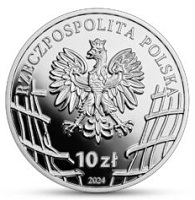

Nominał: 10 zł … Metal: Ag 925/1000; Stempel: lustrzany, tampondruk; Średnica: 32,00 mm; Masa: 14,14 g; Brzeg (bok): gładki; Nakład: do 10 000 szt.; Projektantka: Dobrochna Surajewska; Emitent: NBP. Na każdej polskiej monecie znajdują się: nominał, napis „Rzeczpospolita Polska”, rok emisji, wizerunek orła ustalony dla godła Rzeczypospolitej Polskiej.
Na awersie srebrnej monety przedstawiono rozerwane kraty więzienne. Na rewersie monety znajdują się wizerunki: Zygmunta Szendzielarza „Łupaszki”, Orderu Wojennego Virtuti Militari, wstęgi o barwach Rzeczypospolitej Polskiej z symbolem Polski Walczącej, napis: „Zachowali się jak trzeba” oraz daty urodzin i śmierci „Łupaszki”: 1910–1951.
Zygmunt Szendzielarz urodził się w 1910 r. w Stryju, później rodzina przeniosła się do Wilna. Uczył się w Szkole Podchorążych Piechoty w Ostrowi Mazowieckiej, a następnie w Szkole Podchorążych Kawalerii w Grudziądzu, po której ukończeniu trafił do 4. Pułku Ułanów Zaniemeńskich. We wrześniu 1939 r. jego pułk wszedł w skład Północnego Zgrupowania Odwodowej Armii „Prusy”, a potem Grupy Operacyjnej gen. Władysława Andersa. Por. Zygmunt Szendzielarz dowodził 2. szwadronem. Po wrześniowej klęsce i nieudanej próbie przedostania się do formującej się polskiej armii na Zachodzie pozostał w Wilnie, gdzie organizował konspirację w ramach Związku Walki Zbrojnej. W 1943 r. pod pseudonimem „Łupaszka” Szendzielarz został dowódcą polskiego oddziału partyzanckiego na Wileńszczyźnie, który przekształcił się w 5 Wileńską Brygadę Armii Krajowej, najliczniejszą i najsilniejszą na tych terenach. W latach 1943–1944 Brygada stoczyła kilkadziesiąt bitew z wojskami niemieckimi, z pozostającymi w służbie III Rzeszy formacjami litewskimi oraz z sowiecką partyzantką terroryzującą Polaków. W styczniu 1944 r. komendant Okręgu Wileńskiego AK płk Aleksander Krzyżanowski, ps. Wilk, odznaczył „Łupaszkę” Krzyżem Walecznych. Szendzielarz nie ufał Sowietom i nie wziął udziału w powstaniu wileńskim (operacja „Ostra Brama”). Dzięki temu uniknął rozbrojenia i internowania, co spotkało większość oficerów i żołnierzy wileńskiej Armii Krajowej. Pozostał w konspiracji, odtworzył 5 Wileńską Brygadę, a następnie powołał 6 Wileńską Brygadę. Walkę z Armią Czerwoną i NKWD oraz ich polskimi kolaborantami z UB, MO i Korpusu Bezpieczeństwa Wewnętrznego (KBW) przeniósł na Podlasie, Białostocczyznę, Warmię i Mazury oraz Pomorze. Za jego głowę Sowieci wyznaczyli wysoką nagrodę. „Łupaszka” prowadził także akcję propagandową. Oto fragment chyba najsłynniejszej jego ulotki z marca 1946 r.: „Nie jesteśmy żadną bandą, tak jak nas nazywają zdrajcy i wyrodni synowie naszej ojczyzny. My jesteśmy z miast i wiosek polskich. My chcemy, by Polska była rządzona przez Polaków oddanych sprawie i wybranych przez cały Naród […]”.
Ostatecznie Szendzielarz zaprzestał walki zbrojnej i próbował wrócić do cywilnego życia. W czerwcu 1948 r. UB rozpracował i rozbił Okręg Wileński AK. „Łupaszkę” aresztowano 30 czerwca w Osielcu pod Zakopanem. W pokazowym procesie komunistyczny sąd skazał go na osiemnastokrotną karę śmierci. 8 lutego 1951 r. został zamordowany w katowni UB przy ul. Rakowieckiej w Warszawie. Po 1989 r. sądy oczyściły go ze wszystkich zarzutów. W 2007 r. prezydent RP Lech Kaczyński odznaczył „Łupaszkę” pośmiertnie Krzyżem Wielkim Orderu Odrodzenia Polski za wybitne zasługi dla niepodległości Rzeczypospolitej Polskiej. Szczątki Zygmunta Szendzielarza zostały odnalezione przez pracowników Instytutu Pamięci Narodowej na tzw. Łączce na Powązkach Wojskowych; w sierpniu 2013 r. IPN ogłosił ich identyfikację. Informacja: Tadeusz Płużański.

The Enduring Soldiers Accursed by the Communists –
Zygmunt Szendzielarz “Łupaszka”
www.nbp.pl
Narodowy Bank Polski holds the exclusive right to issue the currency of the Republic of Poland, including collector coins and banknotes. All coins and banknotes issued by NBP are legal tender in Poland. Issuing collector items is an occasion to commemorate important historic figures and anniversaries as well as to develop the interest of the public in Polish culture, science, and tradition. On 27 February 2024, Narodowy Bank Polski issued into circulation a silver coin of the series “The Enduring Soldiers Accursed by the Communists” – “Zygmunt Szendzielarz ‘Łupaszka’ ”, with a face value of 10 złoty.


Face value: 10 zł … Metal: Ag 925/1000; Finish: proof, pad printing; Diameter: 32.00 mm; Weight: 14.14 g; Edge (side): plain; Mintage: up to 10,000 pcs; Designer: Dobrochna Surajewska; Issuer: Narodowy Bank Polski. The coins, commissioned by Narodowy Bank Polski, were struck by Mennica Polska S A. All Polish collector coins feature: face value, inscription: Rzeczpospolita Polska, year of issue, image of the Eagle established as the state emblem of the Republic of Poland.
The obverse of the silver coin features prison bars torn apart. The reverse of the coin carries the images of Zygmunt Szendzialarz ”Łupaszka”, the War Order of Virtuti Militari, a white-and-red flag with the symbol of Fighting Poland, the inscription: “Zachowali się jak trzeba” (“They acted as they should”) and 1910–1951 (Łupaszka’s dates of birth and death).
Zygmunt Szendzielarz was born in Stryj in 1910. His family moved afterwards to Vilnius. He studied in the Infantry Cadet School in Ostrów Mazowiecka, and then in Cavalry Cadet School in Grudziądz. Having graduated from there, he was assigned to the 4thNiemen Uhlan Regiment. In September 1939, his regiment formed part of the Northern Grouping of the Reserve Army “Prusy”, and then of General Anders’ Operational Group. Lt. Zygmunt Szendzielarz commanded the 2nd squadron. Following the defeat and a failed attempt to get through to the forming Polish army in the West, he stayed in Vilnius, where he organized the local underground under the auspices of the Union for Armed Struggle (Związek Walki Zbrojnej). In 1943, under the nickname “Łupaszka”, Szendzielarz became commander of a Polish guerilla unit in the Vilnius District, which morphed into the Home Army 5th Vilnius Brigade, the most numerous and the strongest in the region. In 1943–1944, the brigade fought in several dozen battles and skirmishes with German troops, with Lithuanian formations collaborating with the Third Reich and with the Soviet partisans terrorizing the Polish populace.
In January 1944, the commander of the Vilnius District, Colonel Aleksander Krzyżanowski, nickname “Wolf”, awarded “Łupaszka” with the Cross of Valour. Szendzielarz did not trust the Soviets and did not participate in the Vilnius uprising (Operation Gate of Dawn). Thanks to this decision, he evaded disarmament and internment, which befell most soldiers and officers of the Vilnius branch of the Home Army. He remained in the underground, rebuilt the Home Army 5th Vilnius Brigade, and then he established the Home Army 6th Vilnius Brigade. He moved the fight with the Red Army and the NKVD as well as with their Polish collaborators from the communist secret police, state police and military counterinsurgency corps to Podlachia, the Białystok region, Warmia, Masuria and Pomerania. The Soviets put a bounty on him. “Łupaszka” also conducted propaganda work. A fragment of probably his most famous leaflet, dated March 1946, reads: “We are not a band, as traitors and the impious sons of our homeland call us. We come from Polish cities and villages. We want Poland to be ruled by Poles committed to its cause and elected by the entire Nation […]”.
Finally, Szendzielarz abandoned the armed struggle and tried to return to civilian life. In June 1948, the secret police figured out and broke the structures of the Home Army Vilnius District. “Łupaszka” was arrested on 30 June in Osielec near Zakopane. In the subsequent show trial organized by communists, he was sentenced to death penalty on eighteen counts. On 8 February 1951, he was murdered in the secret police torture chamber at Rakowiecka Street in Warsaw. After 1989, courts exonerated him from all charges. In 2007, the President of the Republic of Poland, Lech Kaczyński awarded “Łupaszka” post mortem with the Grand Cross of the Order of Polonia Restituta for outstanding service to the independence of the Republic of Poland. Zygmunt Szendzielarz’s remains were found by the experts of the Institute of National Remembrance on a site of clandestine burials performed by the communist secret police – the so-called Łączka (Meadow) in the Powązki Military Cemetery in Warsaw. In August 2013, the Institute of National Remembrance confirmed his identity. Info: Tadeusz Płużański.


Wildflowers booklet of 10 Permanent™ stamps
www.canadapost.ca
This year’s issue in the annual Flowers series includes two stamps featuring the native wildflowers butterfly milkweed (Asclepias tuberosa) and spotted beebalm (Monarda punctata). These wildflowers are important sources of food for a variety of pollinators, including hummingbirds and insects such as butterflies and bees.
Rich with nectar and pollen, the brilliant blossoms of butterfly milkweed (Asclepias tuberosa) and spotted beebalm (Monarda punctata) are abuzz during blooming season, as hummingbirds and insects such as butterflies and bees stop by to feed.

Butterfly milkweed boasts tall, flat-topped clusters of pale to dark orange flowers. Its glossy, lance-shaped leaves – and the leaves of other milkweeds – are the sole source of food for monarch butterfly caterpillars. A fragrant member of the mint family, spotted beebalm is known for its unique and intricate appearance. Whorls of purple-spotted tubular flowers alternate with rings of white to purple leaf bracts at various points along the upper stem. In Canada, the two wildflowers are native only to certain regions of southern Ontario and southwestern Quebec. In Quebec, they are designated as threatened and protected by law. Also grown commercially, these plants are a good choice for gardens, since they support pollinators and make beautiful ornamental and cut flowers.
The front cover and two inside panels of the stamp booklet feature illustrations of the two wildflowers, with a common eastern bumble bee (Bombus impatiens) visiting the flowers on the cover. The booklet also includes 10 envelope seals featuring the two wildflowers. Stamp Value: Permanent™ domestic rate; Stamp Designer: Andrew Perro; Stamp Illustrator: Alain Massicotte; Quantity Produced 1,000,000; Issue Date: March 1, 2024.

The Souvenir Sheet features the two stamps, along with an illustration of spotted beebalm and butterfly milkweed being visited by a common eastern bumble bee. Stamp Value: Permanent™ domestic rate; Stamp Designer: Andrew Perro; Stamp Illustrator: Alain Massicotte; Quantity Produced 50,000; Issue Date: March 1, 2024.

Wildflowers Official First Day Cover … The OFDC is cancelled in Essex, Ontario. The cancel location was chosen because of the region’s abundance of native milkweed, which makes it an important breeding ground for monarch butterflies before their annual migration to Mexico. The cancel image is a line drawing of the two featured wildflowers. Stamp Value: Permanent™ domestic rate; Stamp Designer: Andrew Perro; Stamp Illustrator: Alain Massicotte; Quantity Produced 6,000; Cancellation Site: Essex, Ontario; Issue Date: March 1, 2024.


$20 Pure Silver Coin – This Is Canada:
Wondrous Waters – Pacific Coast (1)
www.mint.ca
A new annual series, This Is Canada invites you to (re)discover the sights and species that inspire awe and pride for this country! Wondrous Waters is the theme for 2024, as we embark on a four-part exploration of the waters that surround us, beginning with the Pacific Ocean, which is highlighted on the series’ first 99.99% pure silver coin.
British Columbia is considered the most biologically diverse of the 10 Canadian provinces, and much of that diversity is focused along a coastline punctuated by islands and fjords. It’s easy to lose yourself in this spectacular setting where mountains and forests meet the sea, which is home to the long-revered cultural icon of the Pacific coast: the orca. Coin #1: This is our Pacific coast. This is Canada.
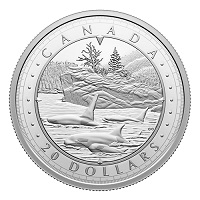
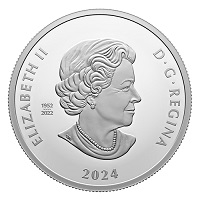
Face Value: 20 dollars … Composition: 99.99% pure silver; Mintage: 7,500; Weight: 31.39 g; Diameter: 38 mm; Edge: Serrated; Finish: Proof; Artist: Glen Green (reverse), Susanna Blunt (obverse); Packaging: Black clamshell with graphic beauty box.
DID YOU KNOW? … ***“Orca” or “killer whale”? Both names are commonly used. “Orca” comes from the species’ Latin name, Orcinus orca, meaning “of the realms of the dead”. As for “killer whale,” it’s been said that sailors used to call it “whale killer” after seeing it prey on whales, and that nickname likely morphed into “killer whale”—the killer of whales. ***The largest member of the dolphin family (Delphinidae), orcas are highly social creatures that travel and hunt in tight-knit pods led by an older matriarch. Pod members communicate through group-specific vocalizations, like a unique dialect, and cooperative behaviours are transmitted to the next generations—like the calf on your coin’s reverse! ***In Canadian Pacific waters, you’ll find three different orca populations: the fish-eating northern and southern (depending on their preferred locations) residents; the mammal-eating Bigg’s/transient orcas who travel between California/Mexico and Alaska; and the offshore orcas who rarely come close to land. Each type is distinguished by their lifestyle and unique social behaviours.
Your coin’s reverse travels to British Columbia for a view of Canada’s Pacific coast. Designed by B.C. artist Glen Green, this iconic coastal view shows a pod of orcas (Orcinus orca) travelling in the waters near a rocky island, while in the background, mighty forests and mountains line the shore. Compass elements surround the engraved portrait to form a frame that contains the word “CANADA” and a face value of “20 DOLLARS”. The obverse features the effigy of Queen Elizabeth II by Susanna Blunt. The obverse also bears a special marking that includes four pearls symbolizing the four effigies that have graced Canadian coins and the double date of her reign.
Glen Green, Artist … As soon as I was granted the opportunity to create a design representing the West Coast, my mind immediately went to the majestic orca. I live on Vancouver Island and occasionally get to see pods of killer whales on my travels. The background of this design, with the rocky islands and the heavily forested mountains cascading down to the rugged shoreline, is typical of the West Coast. To many who witness these whales patrolling the coast, especially with a calf in tow, it is one of the most spectacular experiences one can have in their lifetime!

$20 Pure Silver Coin – This Is Canada: (2)
Wondrous Waters – Arctic Coast
www.mint.ca
Canada’s coastline is the longest in the world and two-thirds of it lies in the Arctic. Most of this coastline wraps around the many islands that lie near the top of the world, such as Baffin Island and the Queen Elizabeth Islands. Nowhere is the connection between land and sea more evident than along our vast northern coast, where life follows the seasonal cycle of sea ice—a critical habitat for polar bears, seals and more. As represented on our second This Is Canada: Wondrous Waters coin, the Arctic coast is teeming with hidden wonders and endless beauty—from iconic wildlife to the tundra landscape that comes alive each summer, and the cultural ways that have left a deep imprint on Canada’s northern identity. Coin #2: This is our Arctic coast. This is Canada.

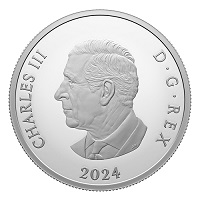
Face Value: 20 dollars … Composition: 99.99% pure silver; Mintage: 7,500; Weight: 31.39 g; Diameter: 38 mm; Edge: Serrated; Finish: Proof; Artist: Myrna Pokiak (reverse), Steven Rosati (obverse); Packaging: Black clamshell with graphic beauty box.
DID YOU KNOW? … *** While the Arctic Ocean is the smallest and shallowest of the world’s oceans, Canada’s Arctic and northern region is incredibly vast—it represents nearly 40 percent of this country’s total landmass and freshwater. *** Berry picking and gathering wild plants is an important cultural activity in Inuit Nunangat, especially in late summer and fall. Arctic cranberries, blueberries, cloudberries and crowberries are some of the most commonly picked varieties. *** Canada’s Arctic is home to beluga whales and narwhals, as well as two-thirds of the world’s polar bear population.
Your coin’s reverse presents an artistic representation of Canada’s Arctic coast. Designed by Inuvialuit artist Myrna Pokiak and inspired by the artist’s experiences, the moonlit scene features a berry picker to represent traditional foods and harvest activities on land, where the flat tundra is punctuated by a pingo. A snowy owl has taken flight and the tail of a beluga whale appears in the water that lines the shore, which is marked by caribou tracks and those of a polar bear. The beach is also lined with driftwood carried to the Arctic coast by rivers and ocean currents, making it a symbol of interconnectedness. Compass elements form a frame that contains the word “CANADA” and a face value of “20 DOLLARS”. The obverse features the effigy of His Majesty King Charles III by Canadian artist Steven Rosati.
Myrna Pokiak, Artist … My art depicts pieces of my heart and every element of my design is a memory, a story about living along the Arctic Coast. Animal tracks are evidence of life, and we find the spirits of our ancestors in harmony with the caribou, polar bear, snowy owl, and beluga whale. The landscape highlights the majestic beauty of the coast, from shorelines dotted with pingos and beaches scattered with driftwood carried by the north-flowing rivers, to the receding permafrost that unveils our history and exposes the fragility of the Arctic. The berry harvester is my favourite: it represents the beauty and mouth-watering tastes the Arctic coast has to offer, the soul food that has nourished each generation from as far back as our stories go, all harvested under the light of the sun and moon by people who call the Arctic home.

$20 Pure Silver Coin – This Is Canada:
Wondrous Waters – Atlantic Coast (3)
www.mint.ca
Soaring cliffs, windswept trails and scenic vistas dotted with lighthouses—you’ll find all of these (and more) on Canada’s picturesque Atlantic coast, which is highlighted on the third This Is Canada coin. All along our eastern shores, the fresh salt air and harbours are reminders of how life here has always been closely tied to the sea and to seafarers. Whether you’re viewing icebergs, tall ships, migrating seabirds or a tidal bore, there are countless ways to soak in all the stunning coastal scenery and maritime culture that define the Atlantic Canada experience, a quintessential part of our national identity. Coin #3: This is our Atlantic coast. This is Canada.
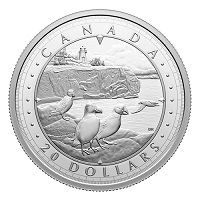

Face Value: 20 dollars … Composition: 99.99% pure silver; Mintage: 7,500; Weight: 31.39 g; Diameter: 38 mm; Edge: Serrated; Finish: Proof; Artist: Bonnie Ross (reverse), Steven Rosati (obverse); Packaging: Black clamshell with graphic beauty box.
DID YOU KNOW? … ***If you want to be one of the first to view the sunrise in North America, head to Cape Spear National Historic Site in Newfoundland and Labrador—it is Canada’s easternmost point, and home to the province’s oldest surviving lighthouse. ***The Bay of Fundy is home to the highest tides in the world. Twice daily, the incoming high tide has enough power and volume to create a travelling wavefront (this leading edge is known as a tidal bore) that pushes water upstream in several rivers in New Brunswick and Nova Scotia. ***The Atlantic puffin spends most of its life at sea, but each spring, the orange-billed seabird (and its mate) returns to its breeding site on the coast of Atlantic Canada. There’s a reason the puffin is the provincial bird of Newfoundland and Labrador: roughly 95% of all North American puffins breed along the province’s coast! ***Wherever you are in Prince Edward Island, you’re only a short drive away from the ocean! One of the most impressive engineering feats of the 20th century, the 12.9-kilometre-long Confederation Bridge connects Canada’s smallest province to mainland New Brunswick.
Your coin’s reverse presents a cliffside view of Canada’s Atlantic coast. Designed by artist Bonnie Ross, the sweeping view features two Atlantic puffin (Fratercula arctica) pairs in the foreground, while in the background, a lighthouse—an icon of Atlantic Canada’s maritime history—is perched atop a rocky cliff and nestled among wind-blown trees. Compass elements form a frame that contains the word “CANADA” and a face value of “20 DOLLARS”. The obverse features the effigy of His Majesty King Charles III by Canadian artist Steven Rosati.
Bonnie Ross, Artist … As the design for this coin progressed, I could almost smell the brine of the ocean and hear the waves gently breaking against the shoreline. In the Atlantic Provinces, we have some breathtaking cliffs and seaside vistas, some of which only the locals know about. Drawing in an endearing puffin family completed the scene and added to the overall perspective.

$20 Pure Silver Coin – This Is Canada:
Wondrous Waters – Great Lakes (4)
www.mint.ca
The Great Lakes form the largest body of freshwater on Earth and they were the main arteries of early Canada—the freshwater seas upon which people and goods have travelled since time immemorial. Though we share these waters with the United States, the pristine wilderness of Canada’s Great Lakes region—so lovingly captured on this fourth coin—has done much to shape the world’s perception of Canada as a place teeming with life, including a number of beloved wildlife species that are regarded as quintessentially, and iconically, Canadian. Coin #4: This is the Great Lakes basin. This is Canada.
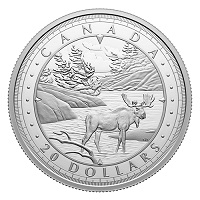

Face Value: 20 dollars … Composition: 99.99% pure silver; Mintage: 7,500; Weight: 31.39 g; Diameter: 38 mm; Edge: Serrated; Finish: Proof; Artist: Claudio D’Angelo (reverse), Steven Rosati (obverse); Packaging: Black clamshell with graphic beauty box.
DID YOU KNOW?… ***The Great Lakes contain 18% of the world’s total surface freshwater. While Lake Erie is the smallest, Lake Superior is the largest, coldest and deepest of the five. Lake Superior contains about 12,100 cubic kilometres of water—more water than the other four Great Lakes combined! ***Moose inhabit almost every Canadian province and territory—in fact, our moose population is estimated to be between 500,000 and 1,000,000. It’s one of the largest mammals in Canada (the polar bear is the largest), where it stays close to lakes, forests and marshes. Moose are known to be good swimmers and divers, and just like humans, they enjoy a cool dip on a hot summer day!
Your coin’s reverse captures the iconic beauty of the landscapes and vistas of the Great Lakes. Designed by Claudio D’Angelo, the idyllic setting was inspired by the rugged shoreline of Georgian Bay, and the scene features a moose (Alces alces) standing in water between rocky islands topped with windswept pines. Compass elements form a frame that contains the word “CANADA” and a face value of “20 DOLLARS”. The obverse features the effigy of His Majesty King Charles III by Canadian artist Steven Rosati.
Claudio D’Angelo, Artist … I love Georgian Bay because it offers some of the most iconic Canadian scenery, with its windswept pines anchored atop islands of exposed Precambrian Shield. That landscape gave me a good excuse to incorporate the moose into the coin design, one of my very favourites subjects. I felt that these two elements—the moose and the landscape—would convey the raw beauty of the Great Lakes region.


$200 Pure Gold Coin –
Tall Ships: Topsail Schooner
www.mint.ca
Sail into history with the third Tall Ships coin. Distinguished by the square sails on its foremast, the topsail schooner featured on the third pure gold Tall Ships coin is a striking example of the sail plan that made this type of tall ship both strong and nimble. The rigging allowed these two- (or more) masted vessels to carry more sail when sailing off the wind. More importantly, the square topsails provided increased sail area for more speed, and, combined with fore and aft sails, made the ship easier to maneuver in heavy seas—an important consideration for coastal trading in the 1800s. Add a third Tall Ships to your growing fleet.
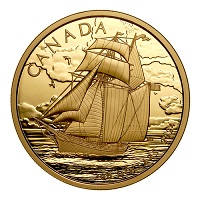
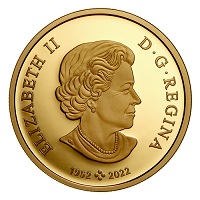
Face Value: 200 dollars … Composition: 99.99% pure gold; Mintage: 800; Weight: 15.43 g; Diameter: 29 mm; Edge: Serrated; Finish: Proof; Artist: Bonnie Ross (reverse); Susanna Blunt (obverse); Packaging: Black clamshell with black beauty box.
DID YOU KNOW? … ***Topsail schooners were used in maritime warfare and were a popular type of privateer ship in the War of 1812. While lower sails could get in the way of the sailors working the guns, the small square topsails were less at risk of being ruined by enemy fire.
The reverse design by Canadian artist Bonnie Ross features a three-quarter view of a two-mast topsail schooner heeled over and with all sails set to catch the wind. The reverse includes the word “CANADA”, a face value of “200 DOLLARS” and the year “2024”. The obverse features the gold effigy of Queen Elizabeth II by Susanna Blunt. The obverse also bears a special marking that includes four pearls symbolizing the four effigies that have graced Canadian coins and the double date of her reign.
The Expert: R. Bruce Macdonald, Author and Captain of North Star of Herschel Island … “The topsail schooner is a two or more masted vessel that carries a fore’n’aft rig on each of her masts but with the addition of one or more square sails rigged onto the foremast. This combination of sails gives the practical and upwind efficiency of a fore’n’aft rig with the added capability of a better downwind or off the wind performance with the square sails. This type of rig was once a common sight in Canadian waters and was used by fishing vessels, cargo ships, and even naval vessels, where the addition of large square sails rigged high aloft meant that there was less chance of them being shot through in battle. One of the better-known ships that carried this rig in Canada was HMS Nancy, made famous during the War of 1812.”


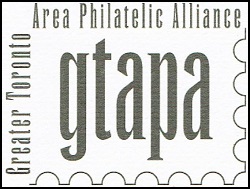
www.gtapa.org
The GTAPA is committed to promote and
stimulate the art of philately to all ages
for fun, culture, education and friendship.




